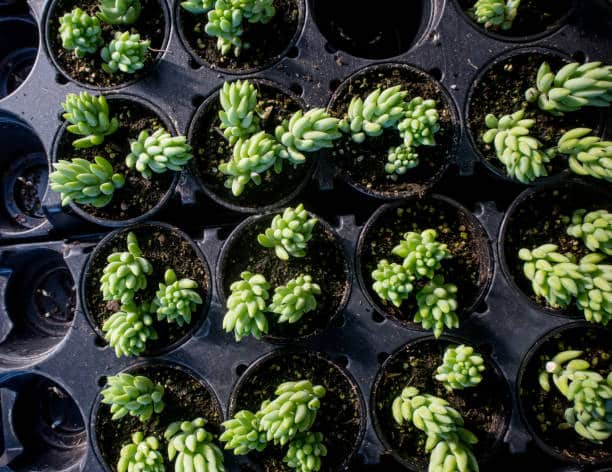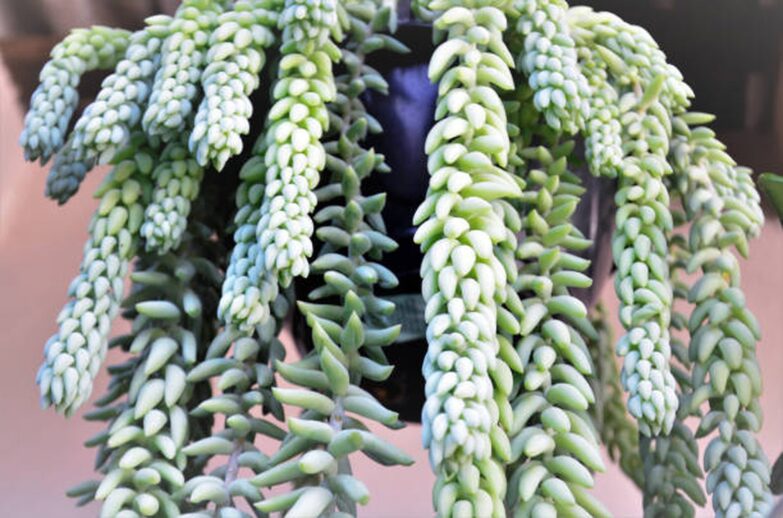Burro’s Tail, also known as Sedum morganianum or Donkey’s Tail, is a captivating succulent with trailing, cascading stems adorned with plump, teardrop-shaped leaves. This charming plant is easy to grow and care for, making it a favorite among both novice and experienced gardeners. In this comprehensive guide, we will explore the ins and outs of Burro’s Tail cultivation, including planting, care requirements, propagation, and common problems.
H2: About Burro’s Tail
Origin and Characteristics
Burro’s Tail is native to the arid regions of southern Mexico and Honduras, where it thrives in rocky crevices and dry, well-draining soils. This succulent is characterized by its long, trailing stems that can reach lengths of up to 4 feet (1.2 meters), making it an excellent choice for hanging baskets and container gardens. The fleshy, blue-green leaves store water, allowing the plant to tolerate periods of drought.
Planting Burro’s Tail
Choosing the Right Container
When planting Burro’s Tail, select a container with drainage holes to prevent root rot caused by standing water. Opt for a shallow, wide pot rather than a deep one, as Burro’s Tail has a relatively shallow root system. Hanging baskets and containers with a wide opening are ideal, as they allow the trailing stems to cascade freely over the sides.
Soil Requirements
Burro’s Tail thrives in well-draining, gritty soil. Choose a commercially available succulent or cactus potting mix, or create your own mix by combining equal parts potting soil, coarse sand, and perlite or pumice. This mixture will provide the proper drainage and aeration needed for healthy root growth.
Planting Procedure
To plant your Burro’s Tail, follow these steps:
- Fill the container with the prepared potting mix, leaving about an inch (2.5 cm) of space below the rim.
- Gently remove the Burro’s Tail from its original container, being careful not to damage the delicate leaves.
- Create a small hole in the center of the potting mix and place the root ball into the hole.
- Gently firm the soil around the root ball, ensuring that the base of the stems is level with the soil surface.
- Water the newly planted Burro’s Tail thoroughly, allowing the excess water to drain away.
Burro’s Tail Care
Light Requirements
Burro’s Tail requires bright, indirect light to thrive. Place your plant near a south or west-facing window, where it will receive plenty of natural light without being exposed to harsh, direct sunlight. If you live in a particularly sunny area, consider providing some light shade during the hottest part of the day to prevent leaf scorching.
Watering and Humidity
As a succulent, Burro’s Tail is drought-tolerant and requires less frequent watering than many other houseplants. Allow the top inch (2.5 cm) of the potting mix to dry out between waterings, and then water thoroughly, allowing the excess water to drain away. Overwatering can lead to root rot, so be cautious not to let your plant sit in standing water.
Burro’s Tail is not particularly sensitive to humidity, and it can adapt to the typical indoor humidity levels found in most homes. However, if you live in a particularly dry area, you can increase the humidity around your plant by placing a tray filled with water and pebbles beneath the pot, ensuring that the pot is elevated above the water level to avoid root rot.
Temperature Requirements
Burro’s Tail prefers moderate temperatures, ideally between 65 and 75 degrees Fahrenheit (18 and 24 degrees Celsius) during the day, and slightly cooler nighttime temperatures. It can tolerate temperatures as low as 50 degrees Fahrenheit (10 degrees Celsius), but it is not frost-tolerant and should be brought indoors or protected from freezing temperatures.
Fertilizing
Fertilize your Burro’s Tail during the active growing season (spring and summer) with a balanced, water-soluble fertilizer formulated for succulents, diluted to half strength. Apply the fertilizer every four to six weeks, avoiding the base of the plant to prevent fertilizer burn. There is no need to fertilize during the dormant season (fall and winter).
Propagating Burro’s Tail

Leaf Propagation
Burro’s Tail is easy to propagate from leaf cuttings. Simply follow these steps:
- Gently remove a healthy, plump leaf from the stem, ensuring that it detaches cleanly at the base.
- Allow the leaf to dry for a day or two until the cut end forms a callus.
- Place the callused end on top of a tray filled with well-draining potting mix, lightly pressing it into the surface.
- Keep the potting mix slightly moist and provide bright, indirect light. In a few weeks, roots and a new plantlet should begin to emerge from the base of the leaf.
- Once the plantlet has developed a healthy root system, transplant it into its own container.
Stem Cuttings
You can also propagate Burro’s Tail from stem cuttings. To do so, follow these steps:
- Using a clean, sharp pair of scissors or pruning shears, cut a healthy stem from the parent plant, ideally 3 to 4 inches (7.5 to 10 cm) in length.
- Allow the cut end of the stem to dry and form a callus for a day or two.
- Plant the callused end in a container filled with well-draining potting mix, burying about 1 inch (2.5 cm) of the stem.
- Water the cutting sparingly until it establishes roots and begins to grow, then care for it as you would a mature Burro’s Tail plant.
Common Burro’s Tail Problems
Pests
Common pests affecting Burro’s Tail include mealybugs, scale insects, and aphids. Regularly inspect your plant for signs of infestation and maintain cleanliness by gently wiping the leaves with a damp cloth. If you notice pests, treat the plant with insecticidal soap or neem oil, following the manufacturer’s instructions.
Diseases
The most common disease affecting Burro’s Tail is root rot, which is typically caused by overwatering or poorly draining potting mix. Ensure that you provide well-draining soil and avoid overwatering to prevent this issue. If your plant shows signs of root rot, such as yellowing leaves or a foul smell emanating from the soil, remove it from its pot, trim away any rotten roots, and repot it in a fresh, well-draining potting mix.
Leaf Drop
It’s not unusual for Burro’s Tail to drop some leaves, especially when the plant is moved or handled. This is a natural response to stress, and the plant will likely recover and produce new growth over time. To minimize leaf drop, avoid moving or handling your Burro’s Tail unnecessarily and ensure it receives the proper care outlined in this guide. If your plant continues to drop leaves despite proper care, consider adjusting the light, temperature, or watering conditions.
Leggy Growth
If your Burro’s Tail starts to develop long, spindly stems with fewer leaves, it may not be receiving enough light. Move the plant to a brighter location with more indirect sunlight to encourage compact, bushy growth.
Conclusion
Burro’s Tail is a stunning, easy-to-grow succulent that adds a touch of whimsy and charm to any indoor or outdoor space. With its cascading, trailing stems and plump, teardrop-shaped leaves, this captivating plant is sure to captivate all who encounter it. By following the planting and care tips in our comprehensive guide, you’ll be well on your way to cultivating a thriving, tantalizing Burro’s Tail of your own.

